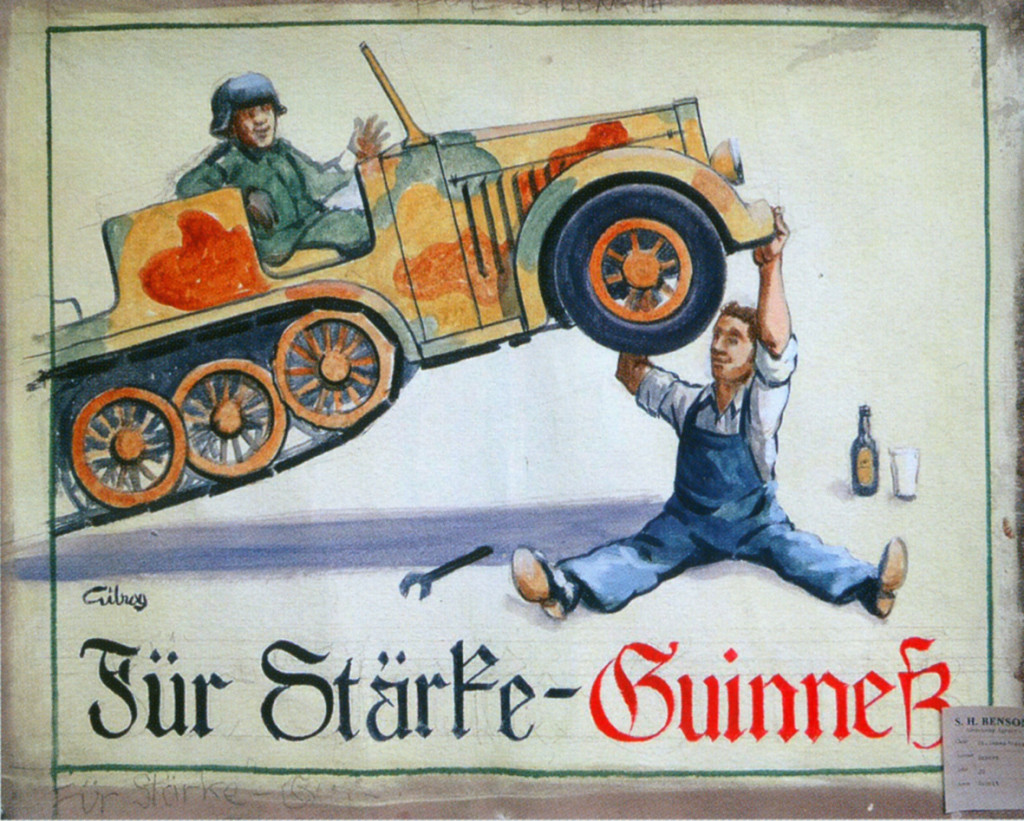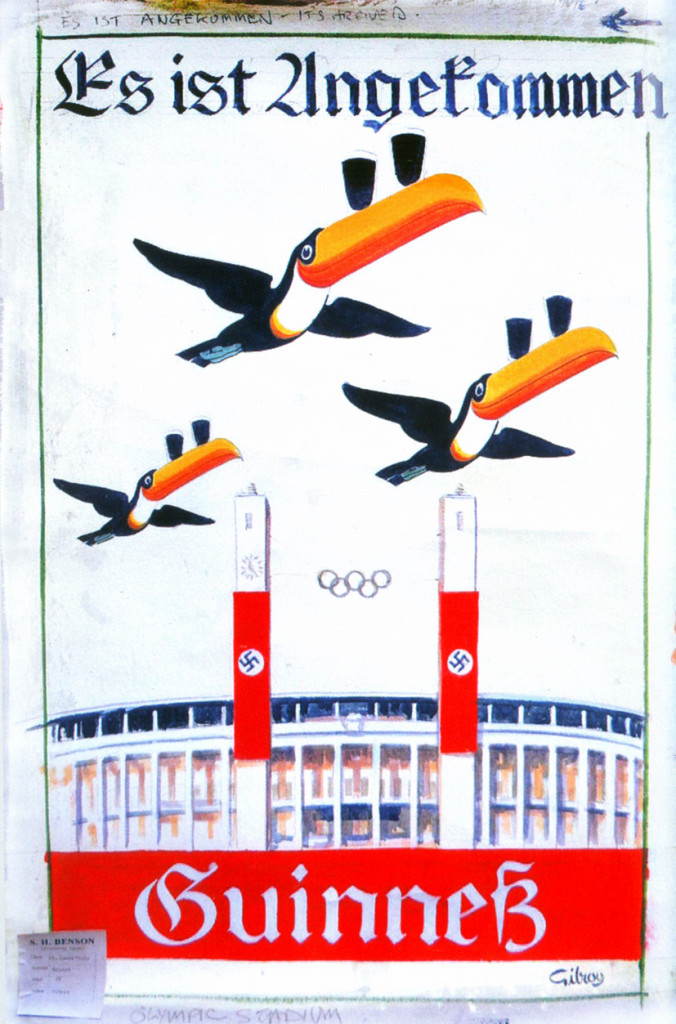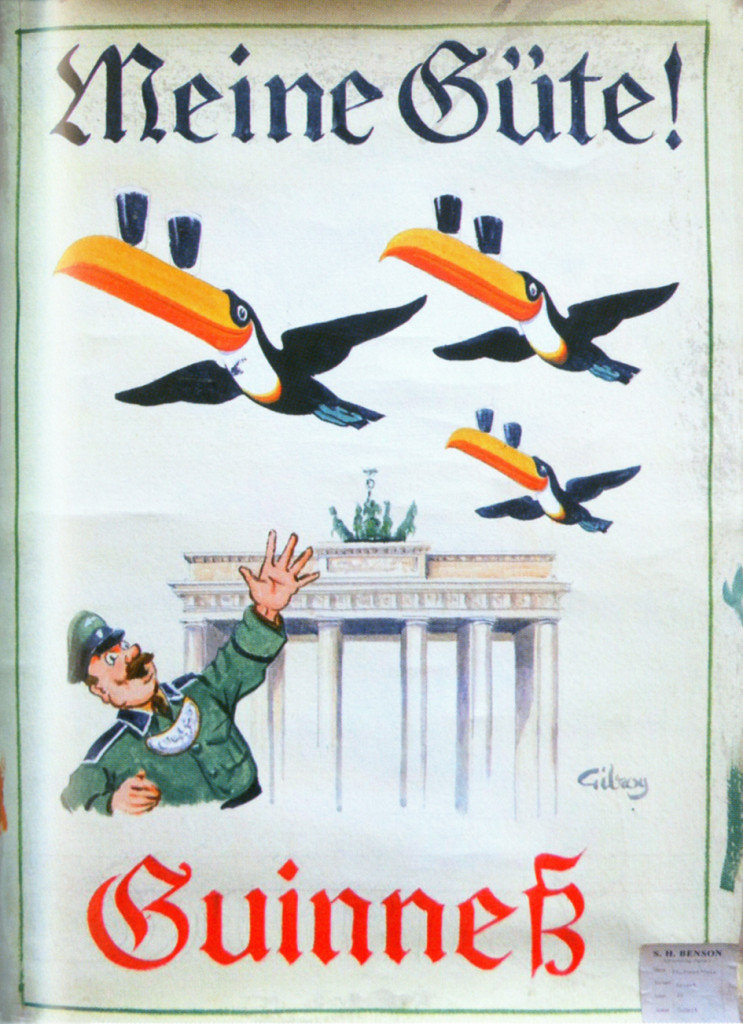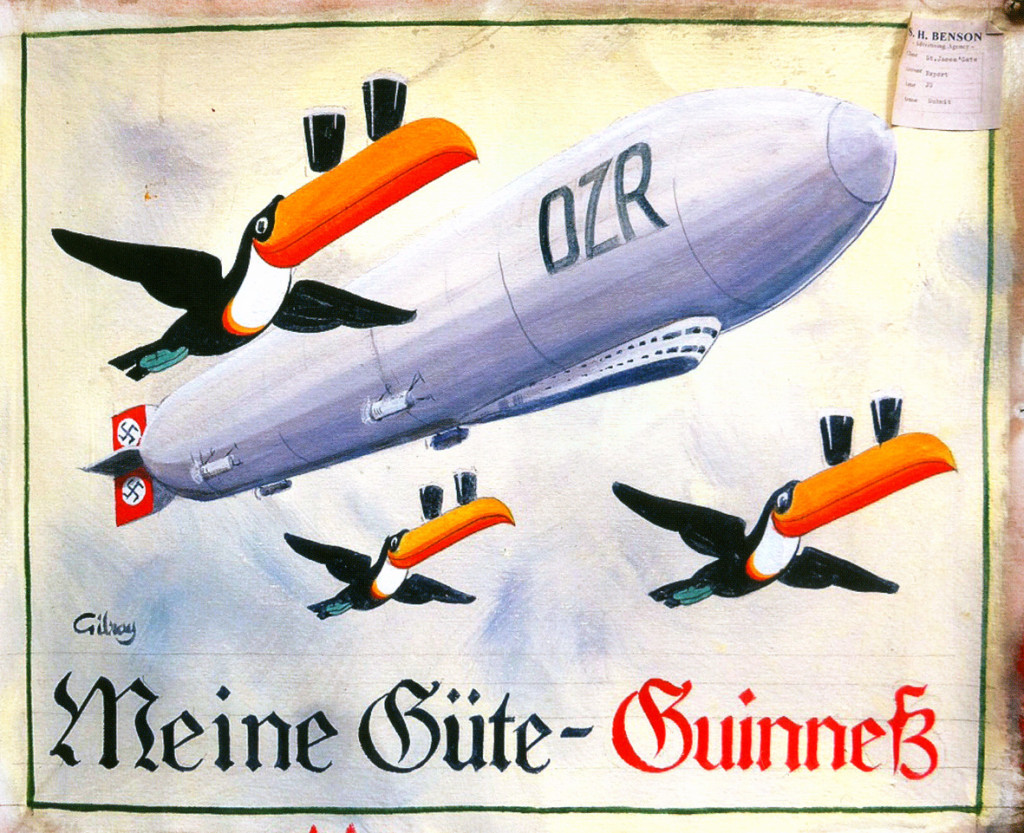
There are some images that are just wrong: uncanny, creepy. One of them is a poster of a smiling, steel-helmeted Nazi-era German soldier holding a pint of stout, with the words in Gothic script: “Es ist Zeit für ein Guinneß!” What makes this poster even weirder is that it’s by John Gilroy, the artist who produced so much classic Guinness advertising imagery, from the flying toucans with glasses of Guinness on their beaks to the Guinness drinker carrying the huge girder. Even people born decades after those ad campaigns ended know the posters.
The German soldier saying: “Time for a Guinness!” is one of a number of images Gilroy produced in 1936 for the advertising agency SH Benson in connection with a campaign in Germany that never went ahead. Today those putative posters look – well – naïve. Guinness-bearing toucans flying over a swastika-draped Berlin Olympics stadium? More Guinness toucans flying escort to a swastika-decorated airship? “Guinness for strength” demonstrated by a mechanic lifting a German army half-track single-handed? Guinness toucans zooming past the Brandenberg Gate, as a man who looks like the Guinness zoo keeper dressed in what appears to be the uniform of the SS Feldgendarmerie stares up, alarmed? (Bizarrely, these were the very first use of the “flying toucans” image, which did not appear in Britain until 1955, and the famous “toucans over the RAF aerodrome” poster.)
 They all appear in a fascinating new book by David Hughes, Gilroy was Good for Guinness, which features a mass of material from the SH Benson archive in London that mysteriously vanished in 1971 and, just as mysteriously, semi-surfaced in the United States a few years ago, when canvases from the archive started appearing on the art market.
They all appear in a fascinating new book by David Hughes, Gilroy was Good for Guinness, which features a mass of material from the SH Benson archive in London that mysteriously vanished in 1971 and, just as mysteriously, semi-surfaced in the United States a few years ago, when canvases from the archive started appearing on the art market.
As well as the German material, there are a host of other draft posters by Gilroy in the book, mostly painted in oil on canvas. Many are for other overseas campaigns that never actually appeared: toucans flying over the Eiffel Tower, the Leaning Tower of Pisa, Brooklyn Bridge and the Kremlin; Greek and Israeli farmers pulling the cart with the horse in (changed to a donkey) to illustrate “Guinness for Strength”: men popping out of manholes and holding up Russian and Israeli steamrollers. There are illustrations of cars, used to advertise Guinness on posters and in calendars, which show what a fine automobile artist Gilroy was – although, again, seeing a picture of Hitler’s six-wheeler Mercedes staff car with “Congratulations from Guinness” underneath, or one of another iconic German vehicle over a pint of stout with the words “VolksWagen – Volks Bier” is weird, weird in an alternative-universe, “What if Germany had won the war?” way. Some are for domestic campaigns that, again never saw daylight: a series of posters for the 1948 London Olympics on the theme of “My Goodness – My Guinness (a sprinter running off with the timer’s pint, for example), and “Guinness for Strength” (a Guinness-powered javelinist hurling his javelin way out of the stadium).
Hughes, who produced the excellent A Bottle of Guinness Please, an extensively illustrated and thorough round-up of the history of Guinness bottling with lots of Guinness-fact goodies (spoilt only by the lack of an index), gives the fullest account I have seen of Gilroy’s life and art in Gilroy was Good for Guinness. I wasn’t going to buy it (on the grounds that I already have far more books on Guinness than any sane man should own) but I couldn’t resist the Nazi Guinness pics.
The book has a good account of Gilroy’s portrait-painting, which included several members of the royal family, and politicians and military men, such as Churchill and Eisenhower. The trouble is that the pictures in the book show Gilroy wasn’t a very good portrait painter, in the sense that his paintings, while technically excellent, just fail to hit the target: they appear to be of entrants in a famous-person-lookalike competition, rather than who they are actually meant to be. If you don’t know who the person is, then nothing appears to be wrong. If you know that it is meant to be, say, Prince Charles, you can see that it isn’t quite right.
It also contains one revelation I certainly didn’t know: that when Benson’s lost the Guinness advertising account in 1969, and thus Gilroy was no longer producing ads for the stout brewer, Guinness felt it owed the artist so much for all the pints and bottles of stout his artwork had helped to shift that it offered him a £2,000-a-year honorarium for life, a sum worth perhaps £27,000 in today’s money: not a huge amount for a man who was a member of the Garrick Club and living in Holland Park Road, Kensington, but much better than a poke in the eye with a paintbrush.
It also attempts to detail the story of the Benson advertising agency’s archive after Benson’s was sold to Olgilvy and Mather in 1971. Somehow the archive, including the Gilroy Guinness collection of original artwork for poster campaigns both used and unused, was sold to, or acquired by, an anonymous American. Parts of the archive began to appear on the market in the United States in 2009. Subsequently more and more of the collection appears to have been disposed of, with canvases selling for up to $14,000. Unfortunately the parts of the story of the archive are scattered through what is an unfortunately frequently bitty book, which could have done with a good editor to pull it all more tightly together. That same editor could have prevented the occasional infelicity and error, such as spelling the name of the actor Kenneth More incorrectly.
All the same, if you’re interested in Guinness, or in breweriana, Gilroy was Good for Guinness is probably worth its £20 price tag. In many ways, it’s Guinness porn at its best. And those German posters really are disturbing.
Update: hat-tip to Boak and Bailey for this – there’s a far better account of the mystery millionaire who bought the Benson’s archive than the book gives, and lots more great illustrations from the book, on the Collectors Weekly website here.





Your link to Collectors Weekly has an erroneous http:// on the end, so it doesn’t work…
Thank you: corrected,
Martyn,
I think there still are many people who might not want to be remembered about their wrong WWII links ?? The problem is that they will definitely sue you if you write about them. I know through the research I did in the hop industry during my time with Yakima Chief of one particular one.
Sincere regards,
Gerard PS – I am a war child – born in the Dutch East Indies were my mother and my siblings were first put in a camp and then into a real prison. People do not realize those traumas will never fade away, they will stay with you for the rest of your life. My Dad was put in Changy prison in Singapore but he made it too, I have written about his life and his war medal some short stories. O I am afriad I still hate the Japs !!
I guess it’s all a matter of perspective. In 1936, without the benefit of hindsight, Gilroy was just doing his job – a graphic artist creating adverts. It pays the bills. He did plenty for the war effort in Blighty. It’s only a WWII link subsequently as the war started three years later.
That is frightening — much prefer going for a Burton (summer 40) 😉
I once visited the Guinness museum at their St. James Gate brewery in Dublin, and I was shocked at how much history Guinness (the brewery) and Guinness (the family) is wrapped up in. But I’m betting you could find stuff like this for any iconic company- I bet Coca Cola has some pretty interesting stuff locked up in their archives.
– Dennis, Life Fermented Blog
A fascination piece, Martyn – thanks for posting it. Happy Christmas. Jan Toms
Excellent piece! I’ve posted it over on my Facebook page, and shared it with some folks at work (my company deals with Guinness here in the Pacific Northwest). Hopefully this book gets released in the US, I’d love to check it out.
I’m going to get reeeeeeal nerdy, here.
It’s interesting that the posters were done in ’36. The halftrack in the poster bears all the hallmarks of the Sd.Kfz.7—”U” shaped doors openings; air vents on the engine housing that go behind the rounded front wheel fenders; the third track wheel superimposing the second; even the position of the headlamps is nearly identical. The only significant difference to the .7, other than minor details, is that the fender overtop the track in Gilroy’s representation is rounded, and it was angular, at the front of the vehicle (the back however, was rounded.)
Here’s what’s interesting, the development of that model of Sonderkraftfahrzeug started in ’34, but it didn’t go into production until ’38. Gilroy seems to have painted a Wehrmacht halftrack that wasn’t in official service at the time he painted it.
Craig, that’s marvellous – that’s exactly the sort of comment I love on this blog, and I was half-hoping for someone to post something like that.
You’re quite welcome, I’m always rather excited when the two great loves of my life—beer and WWII—converge!
[…] Ein Volk, Ein Riech, Ein Guinness, From Martyn Cornell, Zythophile blog […]
[…] Gilroy created these images in 1936 for the advertising agency SH Benson, notes Zythophile. But the camping to get Nazis drinking Guinness was never […]
[…] same. It doesn’t help things that the other adverts Guinness envisioned appearing in Nazi Germany also happened to rehash what ended up becoming some of Guinness’ most iconic posters. For […]